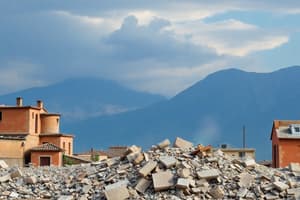Podcast
Questions and Answers
What is the focus or hypocenter of an earthquake?
What is the focus or hypocenter of an earthquake?
The focus or hypocenter is where the earthquake originated, usually underground on the fault zone.
What is the epicenter of an earthquake?
What is the epicenter of an earthquake?
The epicenter is the point on the surface of Earth directly above the focus.
What is a fault plane?
What is a fault plane?
A fault plane is a weak point within a tectonic plate where pressure can cause an earthquake.
What do earthquake waves do?
What do earthquake waves do?
What does magnitude refer to in the context of earthquakes?
What does magnitude refer to in the context of earthquakes?
What is the definition of intensity in relation to earthquakes?
What is the definition of intensity in relation to earthquakes?
What is seismology?
What is seismology?
Who studies earthquakes?
Who studies earthquakes?
What are aftershocks?
What are aftershocks?
What are foreshocks?
What are foreshocks?
Which type of fault has movement that is up or down?
Which type of fault has movement that is up or down?
Which type of fault exhibits horizontal movement?
Which type of fault exhibits horizontal movement?
What type of fault has both strike-slip and dip-slip movements?
What type of fault has both strike-slip and dip-slip movements?
Flashcards are hidden until you start studying
Study Notes
Earthquakes
- An earthquake's focus (hypocenter) is where it originates, usually underground on a fault zone.
- The epicenter is directly above the focus on the Earth's surface.
- A fault is a weak point in a tectonic plate where pressure can cause a break and shaking.
- Earthquake waves travel through and on the Earth's surface, causing shaking and vibrations.
Earthquake Strength
- Magnitude describes the energy released during an earthquake.
- Intensity measures the severity of ground shaking at a specific location.
- Seismology is the study of earthquakes.
- Seismologists are scientists who study earthquakes.
Earthquake Types
- Aftershocks are smaller earthquakes that occur after a larger earthquake in the same area. They are caused by the area readjusting to the fault movement.
- Foreshocks are smaller earthquakes that precede a larger earthquake in the same area. Not all earthquakes have foreshocks or aftershocks.
- An earthquake swarm is a series of similar-sized earthquakes occurring over months.
Fault Types
- A dip-slip fault has movement up or down, parallel to the inclined fault surface.
- Normal fault: The hanging wall moves down relative to the footwall.
- Reverse fault: The hanging wall moves up relative to the footwall.
- A strike-slip fault has horizontal movement, parallel to the strike of the fault. The fault blocks move laterally, either left or right.
- An oblique-slip fault combines both strike-slip and dip-slip movements.
Studying That Suits You
Use AI to generate personalized quizzes and flashcards to suit your learning preferences.




